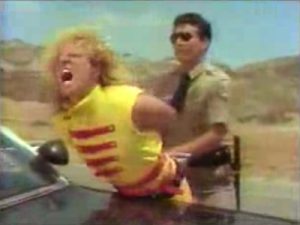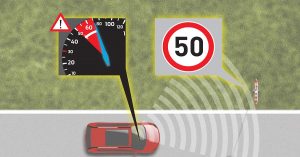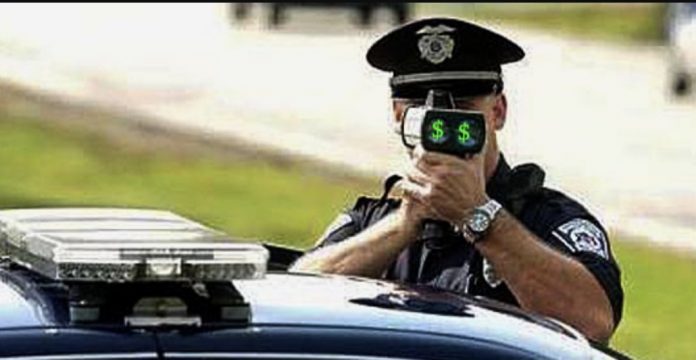Speed limits are about to become limitless – as in, whatever those who set them say they are.
This has always been true, to an extent – in that all speed limits are, to a degree, arbitrary. People are subject to a ticket – i.e., to being extorted by armed government workers, acting on behalf of the government – simply for driving faster than a number posted (by the government) on a sign.
There is an asserted correlation between driving faster than whatever the number on the sign happens to be and the odds of an accident occurring. But this is the motor vehicle code equivalent of “asymptomatic spread.”
The assertion is not the fact.
But to date, there has been a mitigating degree of objectivity. It is called the 85th percentile speed. It refers to the number you get when you watch and record the flow of traffic on a given stretch of road – and it means the speed that almost all the cars do not drive much faster than, irrespective of whatever the number on the sign happens to be.
This speed is taken to be a more-or-less reasonable – a safe – speed for the road on that basis, since it is assumed that most people haven’t got a death wish and will naturally operate at speeds that are reasonable for the road and for conditions as well as their own skills and the capabilities of their vehicle.
There is a federal regulatory publication styled the Manual on Uniform Traffic Control Devices (MUTCD) published by the Federal Highway Administration, which specifically advises use of the 85th percentile rule to set formal speed limits – usually within 5 MPH of the observed 85th percentile speed.
The idea being to set the limit such that most drivers aren’t “guilty” of “speeding” . . . for driving at reasonable, safe speeds. And subject to trumped-up tickets on that basis.
Also, to encourage mostly uniform speed – which is itself a traffic safety consideration. The phenomenon of speed variance – some cars moving much faster (or much more slowly) than other cars – creates less predictable conditions and that can be a problem, too. At least, when other drivers aren’t regularly scanning mirrors and keeping track of their vehicle’s position relative to other traffic.
That problem, of course, could be greatly diminished by improving the general cut of the average driver’s jib – as by expecting more of drivers, as in Germany.
Speed variance on the Autobahn can be in excess of 100 MPH – a Porsche running 180 and a Ford Focus doing 80. The driver of the Ford keeps out of the left lane – unless he’s passing someone doing 60 – and he is expected to be always looking for the Porsche, so as to not be in its way. If he sees flashing headlights coming up in his rearview, he moves right – immediately. The Porsche expects this courtesy and so doesn’t have to worry about slamming on his brakes to avoid a discourteous – a dangerously oblivious – driver.
The Autobahn was able to have no speed limits at all – and a lower incidence of accidents than the U.S. Interstate Highway system – because more was expected of German than American drivers.
We have the 85th percentile speed.
Which has at least served to delegitimize speed limits set well below it – which made it harder to legitimize the kinds of egregious speed limit enforcement made infamous by small towns that derived much of their “revenue” via them.
There was also the absurd 55 MPH National Maximum Speed Limit (NMSL) which lowered 85th percentile highway speed limits from 70-75 MPH to 55 – for almost 20 years, from the mid-1970s through the mid-1990s. Millions of Americans were “pulled over” and essentially robbed at gunpoint – both by the man with the gun and then by the insurance man – for driving at speeds that had been legal and were within the 85th percentile prior to the arbitrary reduction of those PSLs – posted speed limits – by 15-20 MPH.
We may soon not even have the 85th percentile speed as a bulwark against completely arbitrary speed limits and ferocious enforcement, everywhere.
The Federal Highway Administration is apparently about to toss the requirement in the MUTCD that posted speed limits conform with and are based upon the 85th percentile speed.
What this means, in everyday terms, is that states and counties and cities would be unbound from any obligation to limit how low they decree speed limits to be, according to any objective standard. (You can review the full text of the proposed changes here.)
Instead, local/state bureaucrats would be free to post limits in accord with whatever they say – whatever they assert – to be “safe” speeds. It would be the return of Drive 55 – with a vengeance.
Because it is not 1974 and the technological means for mass enforcement exists, as for example by photo radar for one and – more ominously – the in-car capability most new cars have to monitor, record and transmit how fast the car is traveling in real time, all the time. Every “violation” of arbitrary speed limits could be taken note of as it occurs – and the driver automatically dunned, as by an instant “adjustment” of his insurance premium or even perhaps by an automatic deduction of the automated fine from his bank account.
Such things are already practiced (like Sickness Kabuki) in European countries. They could just as easily be practiced here. They already are, to some degree, if you drive commercially. These vehicles are often equipped with such technology, which is why one often sees these vehicles operating within the letter of whatever the law happens to be, no matter how unsafe that might be. As, for example, by slowly pulling out in front of fast-moving traffic . . . in order to avoid the in-car computer taking note of (and reporting) “aggressive” acceleration.
Driving is under systematic attack in this country, in order to achieve the goal of less driving – something that is openly espoused by “new urbanist” advocates of such things as Vision Zero.
A very effective way to attack driving is to make it both miserable and expensive – which would be achieved by getting rid of the MUTCD’s 85th percentile standard, which amount to a kind of Second Amendment for driving rights.
The National Motorists Association – which was largely responsible for getting the 55 MPH National Maximum Speed Limit repealed back in the mid-1990s, after almost 20 years of serial abuse of American motorists – is leading the fight to keep the 85th percentile rule on the MUTCD “books.” So as to maintain at least some objective pressure to set speed limits that correlate somewhat with reasonable speeds.
NMA is a great resource – and an ally of drivers. Here’s a link to some of their material on the subject. And here’s a link to the Federal Highway Administration’s public comment area, which closes May 14th.
If this isn’t stopped, we’re all likely to be stopped. And mulcted. Over and over and over, again. Perhaps to the point that we’ll give up on driving altogether.
. . .
Got a question about cars, Libertarian politics – or anything else? Click on the “ask Eric” link and send ’em in!
If you like what you’ve found here please consider supporting EPautos.
We depend on you to keep the wheels turning!
Our donate button is here.
If you prefer not to use PayPal, our mailing address is:
EPautos
721 Hummingbird Lane SE
Copper Hill, VA 24079
PS: Get an EPautos magnet or sticker or coaster in return for a $20 or more one-time donation or a $10 or more monthly recurring donation. (Please be sure to tell us you want a magnet or sticker or coaster – and also, provide an address, so we know where to mail the thing!)
My eBook about car buying (new and used) is also available for your favorite price – free! Click here. If that fails, email me at [email protected] and I will send you a copy directly!













Eric, I think it’s a mistake to argue that “uniformity” of speed limits should be forced (or even recommended) by the feds when they lack the constitutional authority to do so. Just as it would be dangerous to argue for a federal ban on the Holy Magical Rag. It signals that we’re fine with these creeps bossing state and local governments around, so long as the bossing is in a way that we like. It is the attitude that enabled both 55 and Fauci in the first place.
It’s a bit like when the Republicans build up the power of the executive while the president has an R behind his name, and then are befuddled when a Democrat gets in the White House and uses that power against them. Could they really not see this coming?
It seems the 85th percentile speed is already out of use in most urban and suburban areas with their absurdly low speed limits. My own suburban town has no road with a speed limit higher that 35. Yes, 35! And that includes the highway (that should be at least 65).
The irony of it all. The town fire department posts pictures of car crashes they respond to. They seem to have loads of roll over crashes. How does that happen with the low speeds of the town? Or is it the insane top heavy vehicles of today……
Hi Rich,
I think the target this time (again) is highways. Most are posted 70-75 now and travel averages closer to 80. Imagine the “revenue stream” – and misery – if PSLs were lowered to 60 or even 55.
Glad for the mention of the commercial GPS units in which my employer has gotten even worse with using. Speeding is now an “unforgivable” offense. As these units become more prolific, that 85% average would go down anyways.
Just today, I had to turn out in front of a motorcycle coming the direction I wanted to turn. The motorcycle was more than far enough away for me to pull out, get up to speed, and not be an interruption to their travel if I were allowed to drive like the 85%, but I’m not. I had 3 vehicles behind me waiting (because, duh, I’m slow), so I pulled out slowly (can’t offend the granny nanny), and made my way up to speed +5 mph (won’t get dinged for going that much faster) in enough time not to inconvenience the motorcyclist.
About the time the motorcyclist caught up, I had to make a right onto another road, but as I did, I pulled into a spot where I could pull off and let the motorcyclist by. He looked at me as he drove by and I nodded, then he threw up a hand of thanks as I began to fall in behind him. He soon saw why I pulled off and let him pass. It was a beautiful day and perfect for a bike ride. I was glad to get out of his way and not ruin it with my corporation’s insistence that the driver’s common sense be removed from behind the wheel.
Colorado actually raised the PSL on I25 going through Denver after they completed the undergrounding project. And they’re experimenting with variable speed limits in Glenwood Canyon, dependent on weather conditions. In clear conditions the PSL is 60, up from the static speed limit of 50, but my observation is that because there’s always some sort of maintenance work being done you’ll never get the whole way though the canyon at 60 MPH. Almost as if because changing the speed is a simple press of a button, compared to setting out signage, it will happen more frequently.
https://www.postindependent.com/news/speed-limit-in-glenwood-canyon-to-range-from-30-60-mph-depending-on-conditions/
RK, MoDOT tried VSL signs on I-270 around St. Louis for a while, then took them down. I’d like to think it’s because they recognized the folly of believing they could control actual traffic speed by pushing buttons in their office, but I doubt they are that smart. A MoDOT engineer blamed it on drivers who “don’t really totally get it.”
To Nasir’s comment below, the photo here does show a minimum sign. I suppose they are out there but I just don’t notice them. Call me crazy, but I still think it’s more important to pay attention to what’s going on in front of me than to scan the roadside for a sign that tells me what to do.
https://news.stlpublicradio.org/2013-10-16/modot-removing-variable-speed-limit-signs-on-i-270
Hey Eric, reading this I vaguely remember something as a kid – almost everywhere with a speed limit there used to be a minimum speed sign as well, I guess to speak to the clovers out there. Last few trips ive made to the US did a fair amount of driving, but didnt see any of these signs – whats happened have they gotten rid of them (was that even a thing or am I dreaming it!)
Nasir, now that you mention it, I haven’t seen a minimum speed sign in a long time. The 70/45 combo used to appear on many American interstates. Then again, I don’t spend much time on them these days.
“Keep Right Except to Pass” also used to be common. Sometimes they’d say “Slower Traffic Keep Right,” which was a stupid way of putting it, since any clover going the speed limit could then justify putting down roots in the passing lane with the logic that since no right-thinking person will exceed the posted limit, it’s impossible for him to be “slower.”
Roland,
That’s exactly what they teach you in a “defensive driving” class. If the speed limit is 75, it’s illegal to do 76, even to pass someone, so it is defensible to be in the “passing lane” if you’re doing the speed limit.
Sure does piss people off if you do that, though. Turns the right lane into the passing lane, and gets people offensive about your defensive driving pretty quickly.
Texas is posted all over with “left lane for passing only” signs, and if the state really wanted revenue they could make a fortune enforcing that. The interstates and 4-lane state highways are mobbed with assholes camped out in the left lane. I have to pass on the right at least as often as on the left, and that’s doing just 5-7 over the limit.
Hi P,
Lane courtesy is uncommonly practiced because it is not part of the culture. It is suggested as a “courtesy” rather than an important expression of driving attentiveness and – yup – saaaaaaaaaaaaaaaafety. The typical American driver is passive – and passive aggressive. He does not actively drive. He sits in the driver’s seat. The difference is important!
Vision Zero? Zero Vision. What is the matter with those people in big gov? How can a programmed brainless error prone software program replace a human with a sane brain? It can’t. A human stupid enough to think that software can replace a skilled competent driver is a candidate for a Darwin Award. You’re letting insanity take control and rule. Not good.
You would think the highway patrol would grow weary of driverless car accidents.
Just stay off the roads in droves and they’ll cry in their beer.
To digress, I drive forty miles of back country roads before I hit the blacktop. You can drive hundreds of miles of gravel and only cross a few highways. Usually a two beer drive, more fun that way, twenty miles per beer is a good consumption rate. You see more wildlife when you drive gravel, slow go, but you see much more. Saw seven deer, plenty of pheasant and a moose.
Don’t text and drive, you’ll end up in the ditch. Drink and drive, it’s easy. Just don’t get caught.
Sodium Fluoride
Who gets the ticket if two people are in a car going 90 mph, but neither is in the drivers seat?
‘There was no driver behind the wheel of a Tesla that last night crashed into a tree and burst into flames, costing the two occupants their lives, Texas police report.
‘Investigators say the 2019 Tesla Model S was traveling at a high rate of speed when it approached a slight curve in Spring, a Houston suburb. Instead of navigating the bend, the fully-electric car drove straight off the road and struck a tree.
‘Two men–aged 59 and 69–died in the crash. When their bodies were recovered from the Tesla wreckage (seen above), neither man was seated behind the wheel, cops say. One victim was in the front passenger seat, while the other was in the backseat.’
http://www.thesmokinggun.com/buster/tesla/fatal-texas-tesla-crash-714503
It weren’t me, officer. *Elon took the wheel.*
We asked him to slow down … but HE WOULDN’T LISTEN.
Hi Jim,
This is definitely a very interesting legal question. Arguably, the liability extends to both Tesla and the putative “driver,” who recklessly failed to control his vehicle. I hope his estate is sued into oblivion.
PS: I wonder whether one was in back and one in front Because Rona?
The external combustion engine strikes again.
🤭 External combustion engine, spontaneous-recombustion-in-the-junkyard-two-weeks-later engine….
Even if one of them had been in the drivers seat, those guys didn’t stand a chance. I hear yuppies are making a healthy profit on their stocks though which is all they or Elon care really about anyway, they ought to get behind a podium out in front of the public and thank those guys for their sacrifice.
Good line J. And so true. the external combustion occurring at a power plant.
If you drive where it’s camera heavy, but lacks real live police, how about pulling off your plate?
The state really frowns upon that kinda thing, speedtraps are just dynamic toll booths under the guise of safety lol:
https://www.nj.com/news/2014/09/trucker_charged_with_smearing_grease_on_plates_to_beat_gwb_toll.html
Depending on the camera technology they may still have enough to identify the driver without needing the plates.. And they probably also have little weenie men in security booths watching for ‘cheaters’ to deploy what would’ve been otherwise absent goons. They’d find offenders eventually, they want revenue and/or prison laborers.
Yeah, this falls into the same category as not filing a 1040. If you can get away with it, good for you, but I’m not going to recommend it.
Interesting that libertarians are often accused of utopian thinking, but it’s always the statists who come up with nutty fantasies like zero traffic deaths, eliminating gun violence, and wiping out poverty.
During the Night remove the signs!
One summer several years ago in my small town in southwest NH all of the speed limit signs got repetedly blackedwashed. It was glorious. It should be a nationwide movement to get rid of all these ugly demanding signs. It wouldn’t take much effort either and it would cost our overlords a fortune in time and debtnotes trying to replace them. Same goes for all the electronic eyes and ears growing like weeds in our beautiful country. If they’re busy keeping their satan/sauron systems of control operating perhaps they’d have less time to toss flashbangs into cribs.
The 55 mph limit never went away. When I started driving in 1970, the speed limit on two lane blacktop in Missouri was 65 day, 60 night. Some of the speed limit signs even had reflectivity designed to show the correct speed limit depending on the light source. Sunshine it reads 65, headlights 60. Which was quite close to the appropriate safe speed on such roads that are shared with 5-20 ton farm implements going 15 mph, maybe. When the National 55 mph was dropped, those two lane blacktops kept it. It was raised to 60 on blacktop with a substantial shoulder.
In the rural county I live in, the Sheriff does not have the high volume of high value residential property tax base more urban counties do. With that, along with being a rural resident himself, he tends to operate his department exactly as peace keeping forces should. They don’t go out looking for trouble. They await your call. Consequently, on the 15 miles of State highway I regularly drive on, a couple of days ago I saw a law enforcement vehicle for the first time in over a year. And it was a State Highway Patrol car working an accident. It is a State highway, so they do have jurisdiction.
Of course such pleasure will end when traffic control is automated, and the Feds deliver the necessary tech equipment to enforce it to the County, and compel them to use it. Of course compelling counties to enforce law does not always sell very well to the Sheriff. They are about the last line of defense we have against abject tyranny. Fortunately many of them are quite active in that regard.
Several years ago, when one had to get a permit to buy a handgun from their local Sheriff, he actually encouraged me to get a concealed carry permit, which had just been made available in Missouri. There are real people in the world. Quite a few. Not many of them live in St Louis though.
Hi John,
“ When I started driving in 1970, the speed limit on two lane blacktop in Missouri was 65 day, 60 night.”
When I learned to drive in Wisconsin a few years after you, they had the 5mph less at night too. I think it applied to rain as well.
But since you brought up two lane roads in Missouri, I have a question about a phenomenon I’ve witnessed many times there.
I used to drive from Peru, Indiana to Moberly, Missouri quite often.
When I was on the two lanes in Missouri, if the driver ahead of me was making a left turn, he would signal and move over into the oncoming lane before he hit the brakes. Thus saving me from having to give up the pace.
I would see this happen 5 or 6 times on every trip. After Hannibal all the way into Moberly.
Is this law or simply illegal courtesy?
Never observed anything like that in Illinois or Indiana.
I still drop down the 5mph at night and in the rain unless I’m using cruise. How about you?
No law requiring that lane change for a left turn that I’m aware of, but yes, I’ve seen it done, and usually do so myself, traffic permitting of course. Another courtesy often seen is a slow driver pulling onto the shoulder, or into a driveway, etc. to allow faster traffic to go on by. Of course I never have need of using that courtesy. Given the abundance of deer in the neighborhood, I do slow down at night when you can’t pick them up before they’re in front of you. In the rain, it just depends on visibility, which of course if its bad also will produce standing water on the road. Which you had better slow down for if you intend to stay on the road. Moberly is about twenty-five miles north of where I live.
John,
“ No law requiring that lane change for a left turn that I’m aware of”
But is it allowed by law?
Seems like probable cause in the other states states I’ve mentioned. 🥺
By Missouri law, making a left turn allows one to cross the center line. Obviously, since one cannot make one without doing so. One could quite easily argue that your lane change was a part of the turn. There are abundant “laws” that are constantly ignored. For instance, by Missouri law you must drive as far to the right as possible. If this law was enforced, it would be “illegal” to change to the left lane of a dual lane highway to allow a car coming down the ramp a better and easier chance to merge.
Yep John,
Contradicting law. What a wonderful idea.
John, I remember those day/night signs well. It’s amazing that we went that fast on those roads in the barges of the 1960s.
I have to admit that my distaste for 55 was tempered somewhat when I discovered while a student at Mizzou how much more money I had left for beer if I made my trips home and back at Nixon’s speed instead of 75.
Roland,
Bias ply tires too.
I had a 64 GTO with a 2 speed. 4000 rpm at 55. I was paying attention. At 65 we’re talking white knuckle in the curves
Hi T,
The single most functionally valuable mod I performed on my ’76 TA was to replace the non-OD transmission with a modern OD transmission (.67 ratio in fourth/OD). My car has 3.90 gears in the rear, which – with the original transmission – made it really quick off the line and torturous to drive for any extended time on the open road. At 60 MPH, the engine was spinning around 3,300 RPM – not so good for that long stroke 455, which reds around 5,400 RPM. The OD tranny cut the revs down to around 2,000 at 70 – a huge difference.
And yet the ditches were not full of demolished cars with dead people inside. Those who had difficulty driving that fast were not REQUIRED to do so, and most often did not. To quote a line from “Gumball Rally”, “55 mph, fast enough to kill you, and slow enough to make you feel safe”. Paraphrased of course, since I haven’t seen the movie in decades.
I recently got it on video. I remember going to the theater many decades ago and watching it in full glory.
A forgotten thing about bias ply tires. They handle FAR better on gravel roads than do radials.
Just put some new meats on because the old radials were worn and spinning on the gravel.
I was wondering why the brand new ones do the same.
You’ve answered that question.
I lived in Germany for 3 years, and drove on the Auto Bahn many times. There are many places on the Auto Bahn where your speed is restricted, mostly around cities. There is also a government “recommended” speed of 130KPH, abut 80 MPH, on the areas of the Auto Bahn where no speeds are posted. Sure, you can drive as fast as you want on these stretches, but if you cause an accident, and you were going faster than 130KPH, then you get nailed, and will be found at fault for the accident. At least, that’s what was explained to me.
The great thing about driving on the Auto Bahn compared to our Interstate system was the lack of Clovers meandering along in the left hand lane, usually 5-10 MPH under the speed limit. These types of Clovers do not exist in Germany. The left lane is strictly for passing, not for cruising along oblivious to your surroundings. Germans are very good about driving on the right lane until they come upon a slower moving vehicle, actually using their turn signal to show they are moving to the left lane, pass the slow moving vehicle, and then once again use that turn signal thingy that American Clovers ignore to show they are moving back to the right lane. Of course, there are exceptions. I’ve had my doors blown off many times by Porsche’s, Mercedes’s etc travelling in excess of 200KPH in the left hand lane. I have seen those drivers stay in the left hand lane even when they were finished passing everyone until their tail lights disappeared in the distance.
I was visiting there in 1998 on work. Had a Lancia K 2.4L manual top speed 180 kph. Was awesome to have the pedal to the metal, then have to move over quickly as a car sped by so fast you could not tell what make it was. You definitely had to be awake and looking in your mirror every few seconds. What great driving then, and then having to come back to Victoriastan to a top speed of 110 kph.
Nah, the goal is ZERO driving, by us proles.
Yep, as I have noticed any time I drive south into Utah. Their digital hiway billboards state: “zero fatalities, the only acceptable goal”.
Zero driving is the only way to achieve that goal.
Much like zero ‘rona.
It’s about power & money. Not safety, and not being realistic.
There is a town in my area, which a “highway” went through. Said highway inexplicably dropped to 35 MPH through the town’s jurisdiction and was a notorious speed trap.
The highway was redone & limit raised to 55 MPH, but the locals weren’t given permission to enforce this speed.
Shortly thereafter, the town disbanded their police force – all the while claiming that the speed enforcement wasn’t a revenue generator.
None of this would ever be a problem if the police stayed at the station until called upon.